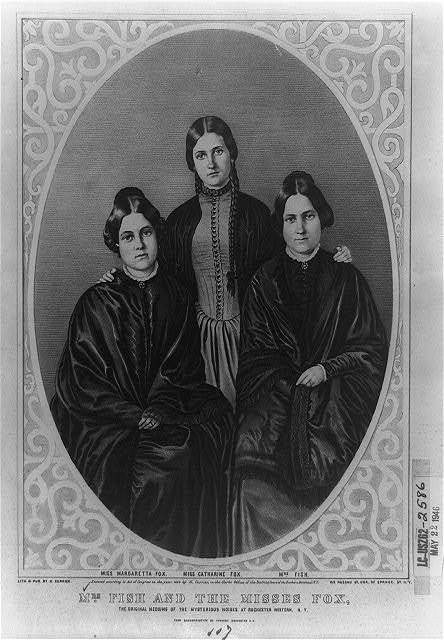By Saundra Mitchell (Guest Contributor)

Mrs. Fish and the Misses Fox: the original mediums of the mysterious noises at Rochester Western, N.Y.
It’s too simple to say that Spiritualism was popular in the 19th century because it was an excuse to behave badly, but it was certainly born from bad behavior.
It was 1848, in Hydesville, New York when the Fox Sisters started “hearing” strange rappings at night. Their house had a reputation for being haunted, and teens Kate and Margaret went along – asking spirits questions, which were answered by knocks and pops. Furniture moved, and the girls had fits they attributed to Mr. Splithoof, the devil.
This could have been a new Salem – Ann Putnam Jr. and Mercy Lewis’ accusations started out much the same way in 1692. But America had changed in the intervening century and a half. Puritanism had been replaced with Evangelicalism – and this time, it wasn’t unopposed.
In 1692, the initial, fervent explanation for the girls’ behavior was witchcraft. But in 1848, medicine understood that typhus was a disease, not a wasting due to too much night air. Messages could be carried spectrally, but scientifically, across telegraph wires. Science crashed against religion, and people wanted to reconcile both.
So when ghosts started knocking in Hydesville, and religion alone couldn’t answer, scientific method stepped in. What was the weight of a soul? You could put the dying on a scale, or you could ask the spirits themselves.
Thus began a movement that swept the western world from the 1840s to the 1920s – sparked by a moment of youthful rebellion. Kate and Margaret Fox were bouncing an apple on the floor when they were supposed to be in bed.
When caught, they told their mother the sound must have been spirits…and she believed.
Saundra Mitchell is the author of The Vespertine, a young adult novel set in Baltimore, 1889 at the height of the Spiritualism craze. She is an Edgar and Pushcart nominee, and a big fan of girls behaving badly.
This post first appeared at Wonders & Marvels on 1 September 2011.
Giveaway is closed.
Would you like an email notification of other drawings? Sign up for our weekly digest in the sidebar.

